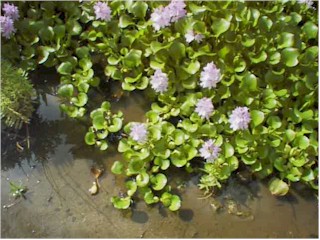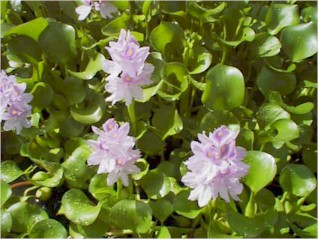 -
- -
-Family: Pontederiaceae
Variants:
Eichornia crassipes
Eichhornea crassipes
 -
- -
-

PLANT CHARACTERISTICS
Family- Pontederiaceae
Genus- Eichornia
Species- crassipes
Growth Form-Herb
Growth Location- Aquatic freshwater
Growth Environment- Freshwater marshes, ponds and waterways
Growth Zone-Temperate to tropical regions
Average Height- ranges from a few inches to over a meter.
Leaf Arrangement- Whorled
Petioles- The petioles are smooth and hollow, allowing oxygen flow up the petiole and buoyancy. At the base of each petiole is a large "buoy" that helps keep the entire petiole structure (including the leaf and flower) above water.
Leaf Blade- The leaf blade is
smooth and leathery. It is round but appears a bit spade-shaped. The sides of the leaf
bend upwards, giving the leaf the impression of a manta ray flapping its wings.
Inflorescence- The inflorescence type is raceme, with the flower pedicels
attaching to a single axis. Usually six to seven flowers grow on one axis. The flower
pedicel is about 2cm - 3cm long.
Flower- Flowers of the hyacinth are actinomorphic or radially symmetric. You can cut the flower in half anywhere and the halves will match. The flowers have both male and female parts; androecium and gymnoecium.
Corolla- Corollas are made up of six petals arranged in a circular rotating position. There is no fusion between petals making the corolla polypetalous. The corolla diameter varies from about 5cm - 7cm. The petals are about 3cm - 4cm high. Every corolla features a "beacon" petal. The top petal has a dark purple-blue spot in the center of it. Within this area is a bright yellow spot. This spot could be a beacon to attract insects that would help pollinate the flower.
Stamens- Each stamen is made up of a pollen-producing anther attached to a long filament. There are usually three long stamens that are easily visible. Three more shorter stamens are found deeper within the corolla.
Ovary- The green ovary is positioned inferiorly, at the bottom of the corolla. It is about 0.5cm long. The ovary is unicarpellate, meaning there is only one ovary connected to a stigma by a style.
Style- Running from the ovary up to the stigma is the style. Usually about 3cm - 5cm, the style is colored white along the first 2cm up from the ovary, and then fades into purple along the last 1.5cm. At the end of the style is the stigma. The tiny white stigma is is funnel shaped and resembles a brush turned upside-down.
Anything else- The water hyacinth is extremely aggressive and invasive, often invading entire ponds and waterways. Hyacinths cover the entire surface they grow on, blocking out sunlight and oxygen to anything trying to live beneath.
Information on Florida's battle against water hyacinth:
http://plants.ifas.ufl.edu/hyacin.html
http://plants.ifas.ufl.edu/hyacin2.html
To quote: "Water hyacinth (Eichhornia crassipes) is one of the worst weeds in the world--aquatic or terrestrial. Until only a few years ago, this floating plant was a major problem in Florida (as it still is in many places throughout the world) covering as many as 125,000 acres of water: boat traffic on several rivers was halted; hundreds of lakes and ponds were covered from shore to shore with up to 200 tons of hyacinths per acre!"
![]() By Robert Churney Jr.
By Robert Churney Jr.![]()